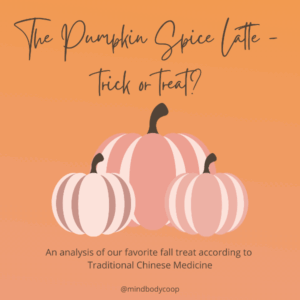An analysis of our favorite fall treat according to Traditional Chinese Medicine.

The Pumpkin Spice Latte is one of the most iconic symbols of fall, instantly recognized for its warm aroma and comforting sweetness. Moreover, this post explores how the Pumpkin Spice Latte connects to Traditional Chinese Medicine. It explains how its warming spices and pumpkin base can nourish the body, mind, and spirit during the seasonal transition to autumn.
“Fall is the season of harvest, a time to pull inward and gather together on all levels, a time to store up fuel, food, and warm clothing, a time to study and plan for the approaching stillness of winter.” – the Inner Classic of the Yellow Emperor, ca. 200 BCE
Likewise, the Pumpkin Spice Latte reminds us that seasonal flavors can connect warmth, nostalgia, and wellness—a theme that aligns beautifully with Traditional Chinese Medicine.
Pumpkin Spice Latte season & the autumnal shift
As the autumnal equinox arrives, the hottest summer on record finally draws to a close. Meanwhile, sunsets begin to line up neatly between the rows of skyscrapers, and this year’s Chicagohenge appears between September 22–25, according to the Adler Planetarium. In addition, nights cool, cicadas soften, and pumpkin spice scents return—signaling the long-awaited reappearance of the Pumpkin Spice Latte.
Furthermore, I’m firmly in the PSL-hate-is-misogyny camp, although I’m more inclined to make a less sugary version at home than to order one from Starbucks or Dunkin’. As a practitioner of Traditional Chinese Medicine (TCM), I appreciate how pumpkin and warming spices can support wellness. Consequently, TCM places herbal medicine and dietary therapy on a continuum, classifying foods and herbs by their temperature, flavor, and the bodily systems they affect.
Traditional Chinese Medicine & pumpkin spice
Autumn, the lung system, and grief
In TCM philosophy, the Pumpkin Spice Latte’s blend of warming spices suits the season particularly well. Specifically, these flavors nourish the lungs and support emotional balance, offering comfort much like the familiar scent of a fall latte on a chilly morning.
Autumn is governed by the metal element, which corresponds to the lung—the respiratory and immune systems. Notably, the lungs are affected by sorrow and grief; for many, fall stirs nostalgia and reflection. Therefore, warming, pungent foods such as those in a Pumpkin Spice Latte can open the airways, bolster immunity, and temper emotional heaviness.
Therapeutic properties of pumpkin & spices
Pumpkin
To begin with, pumpkin is slightly warming and sweet, influencing the lungs and digestive organs. It strengthens qi, regulates circulation, and helps clear dampness and phlegm. Accordingly, the pumpkin base in a Pumpkin Spice Latte contributes nourishment and grounding.
Cinnamon
Additionally, cinnamon—a core flavor in the Pumpkin Spice Latte—is hot and pungent. It strengthens qi and yang energy, disperses cold, and enhances blood flow. As a result, this spice often invigorates both body and mood during autumn.
Nutmeg
Similarly, nutmeg supports digestion, warms the center, and alleviates discomfort. Together with pumpkin, this classic fall latte profile promotes relaxation and balance.
Ginger
Moreover, ginger provides heat and vitality. Its pungency mirrors energizing qualities associated with a Pumpkin Spice Latte, stimulating circulation and clearing a cold. In TCM, it transforms phlegm and aids immunity—crucial in cooler months.
Cloves
Finally, cloves—often present in pumpkin spice blends—warm the center and assist digestion. This fragrant addition, frequently included in Pumpkin Spice Latte mixes, supports both respiratory and digestive systems in TCM.
Together, these ingredients explain why the Pumpkin Spice Latte feels comforting and restorative. Beyond flavor, the traditional spices align with TCM principles that help the body adapt to seasonal change.
Cozy Pumpkin Soup
Just as a Pumpkin Spice Latte provides warmth and contentment, this pumpkin soup offers a similar balance in a savory form. Likewise, both rely on the healing powers of warming spices to soothe the body and lift the spirit.
Ingredients
- 1 medium red or yellow onion, finely chopped
- 2–3 big cloves of garlic, mashed with the tines of a fork
- 2 tbsp coconut oil
- 2 cups peeled fresh pumpkin or kabocha (Japanese pumpkin), cut into dice-sized pieces, or use a 16 oz can of pumpkin puree
- 2 cups chicken or vegetable broth (or substitute coconut milk for half the broth for a richer flavor)
- 1 large bay leaf
- 2-inch piece of fresh ginger, peeled and grated, or 2–3 tsp dried ginger powder*
- ½–1 tsp ground turmeric*
- ½–1 ½ tsp garam masala* (add a pinch at a time)
- Chipotle chile powder or smoked paprika, to taste
- Dash of tamari or soy sauce
- Salt to taste
- *Use less for a milder flavor and more for a spicier flavor
Directions
- Begin by heating the oil over a medium-low flame in a saucepan that holds at least 3 quarts. Once the oil shimmers, add the bay leaf and onion; sauté until the onions soften and turn golden (5–10 minutes). Next, add the garlic and cook another minute or two. Afterward, add pumpkin, ginger, broth, spices, tamari, and optional coconut milk. Bring to a slow boil, stir well, and cover. Continue cooking for 10–15 minutes until the pumpkin softens. Finally, use an immersion blender or mash by hand until smooth.
In the end, this savory pumpkin soup reflects the same comfort as a Pumpkin Spice Latte—warming, smooth, and nourishing on cool autumn days.
When ready to serve, top with coconut milk, roasted pumpkin seeds, cilantro, lime juice, croutons, or Greek yogurt.
